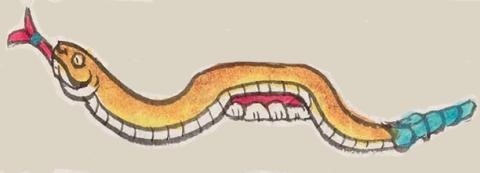Chontal Coatlan (Mdz8r)
This compound glyph for the place name Chontal Coatlan consists of two notable elements. The major one is a snake (coatl) with a turquoise blue rattler and a protruding, red, bifurcated tongue (with a turquoise blue band around the tongue just below where it bifurcates. The snake or serpent is shown in profile, facing to the viewer's left. It is brown on its back, fading to yellow on its belly. There is also a white, segmented stripe along they very bottom of the belly. The other notable element are four, white, front teeth with a band of red gum tissue above the four teeth (tlantli). The teeth, which provide the phonetic value for the locative suffix (-tlan, near) are tucked into one of the curves of the undulating snake body.
Stephanie Wood
The Chontal- part of the place name is not represented visually or not obvious in the iconography of the serpent. Chontal is a language spoken in the state of Oaxaca, where it is one of Tequistlatecan languages, and in the state of Tabasco, where it is one of the Maya languages. Chontal- is the stem for chontalli, which appears in our Online Nahuatl Dictionary as foreigner or stranger. This is why interpreters of the glyph have added the adjective strange, a place of strange snakes.
The coloring of the tongue is reminiscent of a flame. The turquoise color of the rattle certainly draws attention to it. Turquoise has been argued to be the most precious color for the Aztecs. See, for example, the short essay in Mexicolore.
The classic representation of tlantli is to show two, upper, front teeth (see below, right), but teeth can appear in a variety of ways. Here, it seems that four were drawn and painted because they filled that space nicely within the curve of the snake's body. The same was done in the case of the compound glyph for Coatitlan.
Stephanie Wood
chontalcoatlan.puo
Chontal Coatlan, pueblo
Stephanie Wood
c. 1541, or by 1553 at the latest
Stephanie Wood
From the serpent [coa(tl)] to the [tlan(tli)] is a downward movement. But the "Chontal" remains to be assessed.
cohuatl, nombres de lugares, crótalos, ondulante

chontal(li), a stranger or foreigner, https://nahuatl.wired-humanities.org/content/chontalli
coa(tl), snake or serpent, https://nahuatl.wired-humanities.org/content/coatl
tlan(tli), tooth/teeth, https://nahuatl.wired-humanities.org/content/tlantli
-tlan (locative suffix), by, near, among, https://nahuatl.wired-humanities.org/content/tlan
"Chontal Cōātlān" (suggesting that this is the Coatlan in the Maya Chontal area of Tabasco) [Frances Karttunen, unpublished manuscript, used here with her permission.]
"Where There Are Many Strange Snakes" (Berdan and Anawalt, 1992, vol.. 1, p. 178)
"El Coatlan de la Región Chontal" o "Lugar de Víboras Extrañas"
Stephanie Wood (tomando en consideración la traduccion de Karttunen)
Codex Mendoza, folio 8 recto, https://digital.bodleian.ox.ac.uk/objects/2fea788e-2aa2-4f08-b6d9-648c00..., image 26, of 188.
The Bodleian Libraries, University of Oxford, hold the original manuscript, the MS. Arch. Selden. A. 1. This image is published here under the UK Creative Commons, “Attribution-NonCommercial-ShareAlike 3.0 License” (CC-BY-NC-SA 3.0).



